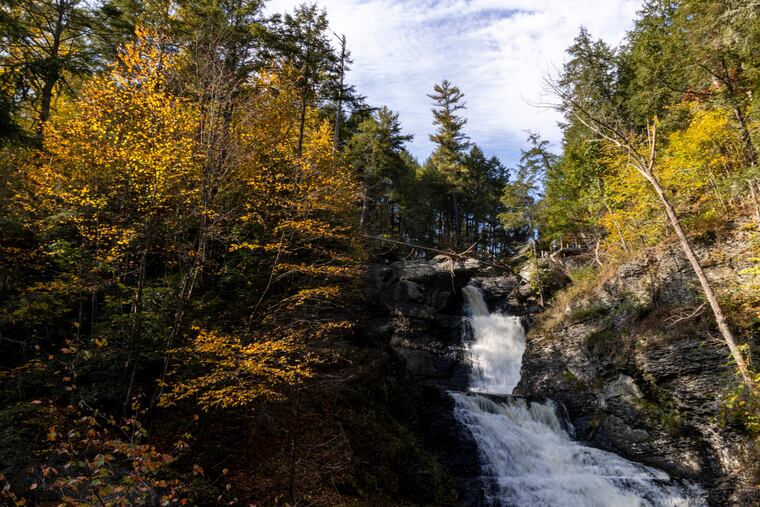Residents fight back against proposed national park at the Delaware Water Gap
The Delaware Water Gap National Recreation Area encompasses 70,000 acres of mountains, forest, and the Delaware River in North Jersey and Northeast Pennsylvania.

LAYTON, N.J. — Alongside fields of wildflowers and on restaurant porches, written large outside a sportsmen’s store above ads for firewood and deer corn, new signs and banners dot the landscape near the Delaware Water Gap in Pennsylvania and New Jersey.
“No National Park,” they read.
The Delaware Water Gap Defense Fund, the group behind the signs, opposes a plan to designate the Delaware Water Gap National Recreation Area as the region’s first national park. Turning the Water Gap into a national park has been talked about for years, but the proposal gained steam last year with the support of the Sierra Club. Proponents say it would bring in up to a million new visitors and secure increased funding.
The recreation area encompasses 70,000 acres of mountains, forest, and the Delaware River in North Jersey and Northeast Pennsylvania. Everyone agrees it’s beautiful there — but is it a national park?
“There’s nothing to see here. Do you see a geyser? Do you see any monumental mountains here?” asked Sandy Hull, a Layton resident who is fighting the park proposal. “This is just a beautifully wooded area.”
A larger concern for Hull is whether the park designation would drive out locals living among the recreation area’s miles of winding country roads because of crowding and eminent domain. They fear centuries-old traditions, like hunting and fishing, will be barred from the park.
John Donahue, who spent 14 years as superintendent of the Delaware Water Gap, is spearheading the park proposal with the support of the Sierra Club.
“This place, basically, already is a national park.” he told The Inquirer last year during a hike near Raymondskill Falls in the recreation area.
The Sierra Club has said turning the recreation area into a national park is an issue of diversity and inclusion, given its proximity to large urban centers. The No National Park group said a fee to enter the park would actually make the area less inclusive.
The Delaware Water Gap is one of the nation’s most popular outdoor destinations, with an estimated 4 million-plus visitors annually. (The visitor tally is one of the things the opposition questions — they believe the number is much lower, the counting process flawed.)
Park proponents estimate that a redesignation would bring an additional 600,000 to 1 million visitors per year.
That’s bad news for one large, regional nonprofit, the Riverkeeper Network, which says such an increase would ultimately affect the water quality of the Delaware River and increase development.
“National Park status will significantly increase the number of visitors to the park in the near term and the long term — thereby increasing the environmental footprint and creating increasing rationale for additional infrastructure including parking lots, sewage treatment and other utility facilities, hotel housing, and other development,” Maya van Rossum, the Delaware Riverkeeper, wrote in a letter to the National Park Service last month.
“It would just be a disaster around here,” said Kristin Albrecht, a resident of Milford, Pike County, who opposes the plan. “The National Park Service can’t afford to maintain what it already has.”
Albrecht said many local businesses oppose the park because they do not want to become a seasonal destination, where numbers spike heavily in the warmer months and drop off when it’s cold.
“During the high season, they know locals won’t come because they know it’s crowded,” she said.
Pennsylvania, New Jersey, and New York have no national park, the nearest being Shenandoah in Virginia, four hours south of Philadelphia. Pennsylvania is home to several national historical parks, including Independence Mall and Valley Forge. While historical parks are prized for their place in history, national parks like Yosemite and Grand Canyon are designated for their natural beauty and resources. There are only nine east of the Mississippi River.
“A national park is the highest level of protection offered by the National Park Service,” Donahue said.
In a recent interview, Donahue stressed that no properties would be taken by the National Park Service in the transition from recreation area to park. He notes that the Water Gap already charges user fees, and his plan does not call for any additional tolls (or toll gates).
Fishing would still be allowed, but the transition to a park would reduce the amount of land where hunting is permitted by approximately 8,000 acres, he said.
Donahue said the park belongs to the people of Wyoming and New York City as much as it does to locals.
He has been presenting the proposal to municipalities and county officials on both sides of the river, trying to build a consensus. Some county commissioners have voted to support the plan, others have not. Neither governor has weighed in on the park proposal, though Cindy Adams Dunn, secretary of Pennsylvania’s Department of Conservation and Natural Resources, said a national park would have “many benefits.”
Ultimately, the national park designation would require an act of Congress.